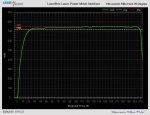- Joined
- Jul 4, 2008
- Messages
- 2,499
- Points
- 113
alright, I just got a new Ophir20C laser head that is new and calibrated. I also have a laserbee II 3.2W pro from J.Bauer that I recently got re-calibrated. I decided to measure a known laser of mine to see if there was any difference between peak and average output between the two sensors. What I found was quite remarkable.
This is a 400mW rated 405nm Olike laser. It has a single glass lens.
Ophir 20C = ~484mW pk (490mW pk cold). 480mW av after 1 minute sample
On the Laserbee, only after 2 minutes do the peaks start to level off and a more realistic peak and average form. The Peak and average after 2 minutes between the Ophir head and the Laserbee is = (1.055x)
Whereas I can obtain a result after 60seconds with the Ophir head.
I have to note that the sample taken is for 1 minute.
I have tried my Daguin 405nm 12x Kryton groove again the difference is
Ophir20C 703mW peak 689mW av
Laserbee II 665.8mW peak 660mW av
1W Olike 445nm
Ophir20C 921mW pk 890mW av
Laserbee II ~873mWpk 843mW av
.... etc ...etc
Comments?
This is a 400mW rated 405nm Olike laser. It has a single glass lens.
Ophir 20C = ~484mW pk (490mW pk cold). 480mW av after 1 minute sample
On the Laserbee, only after 2 minutes do the peaks start to level off and a more realistic peak and average form. The Peak and average after 2 minutes between the Ophir head and the Laserbee is = (1.055x)
Whereas I can obtain a result after 60seconds with the Ophir head.
I have to note that the sample taken is for 1 minute.
I have tried my Daguin 405nm 12x Kryton groove again the difference is
Ophir20C 703mW peak 689mW av
Laserbee II 665.8mW peak 660mW av
1W Olike 445nm
Ophir20C 921mW pk 890mW av
Laserbee II ~873mWpk 843mW av
.... etc ...etc
Comments?







